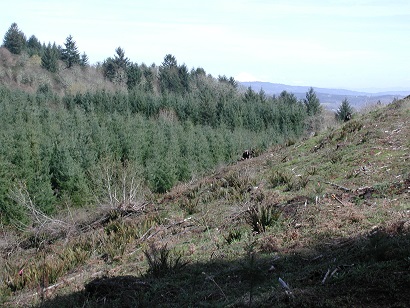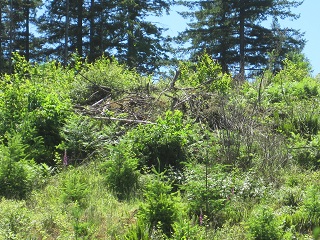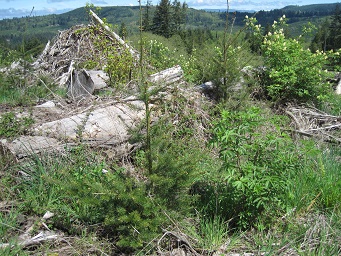Brad Withrow-Robinson, OSU Forestry & Natural Resources Extension agent for Benton, Linn and Polk counties.

Forests disturbed by fire or harvest look different than they did before the disturbance. Just how different depends on the size and intensity of the disturbance, of course. It’s no surprise that a site changed by fire or harvest clearly loses its value to certain wildlife species who like dark, closed forests. But, disturbance creates opportunities for many other species of plants and animals which prosper in the different, more open environment as the forest rebounds.
In a recent post I wrote about forests on the rebound after a severe fire or harvest. Among the animals that depend on and seek out forests on the rebound (called ‘early seral forests’ by ecologists) include pollinating insects (native bees, flies, moths and butterflies) bats and many migratory songbirds such as hummingbirds, some warblers, bluebirds and purple martins.

Some of these animals that use open, disturbed forest sites, notably certain songbirds, and native bees have been declining in recent years.
There is concern that recent changes (over the past several decades) in the amount and character of recently-disturbed forest habitats may be a factor in the decline. These include:
- A dramatic decrease in harvest on federal lands has reduced the amount of young, rebounding forest habitats there.
- Harvest continues on private lands, but and economic and policy incentives, along with modern reforestation practices encourage rapid “green up” after harvest. This has generally shortened the amount of time in the rebound stage between harvest and crown closure.
- Common reforestation practices reduce the amount of broad-leaved shrubs and other vegetation – things we know are important habitat pieces. So, although there is lots of young forest plantations on private lands, they may not be providing good habitat.
- Fewer dead trees (snags) are left in these open areas (after fire or harvest) than were in the past.
- Although wildfire remains a source of disturbance in western Oregon, it is not on the scale that it was in past.
A recent workshop in Corvallis highlighted a near-decade of coordinated research and other efforts to understand the impacts of some of those landscape changes, and particularly the effects of forest management practices on rebounding (early seral) forests, and the wildlife that depends on them.
Teams of scientists at OSU, from private landowners including Hancock Forest Management and Weyerhaeuser, agencies including the US Geological Service, and many others conducted and presented their work. They designed a large randomized study, replicated in eight locations across the northern Coast Range, that compared different intensities of vegetation control (using herbicides) during reforestation. Then they tracked how the vegetation and wildlife responded over the next six or seven years.

The broad take-home message was that early seral biodiversity is compatible with intensive forest management practices. Young forest plantations can (and likely do) provide habitat for many types of animals that depend on rebounding forests. Some species are provided for better than others.
If you are a bird looking for open, brushy cover for roosting and nesting, feed on seeds and bugs you catch on the wing, then many of the conditions created by current forest practices will likely meet your needs. You will also have many new neighborhoods to choose from. If you are a bird who gleans bugs from leaves, like an orange crowned warbler, then it may take a bit longer for the disturbed site to become suitable habitat. But if you are a bat or a bird such as a bluebird or purple martin who also needs snags for nesting and roosting, your needs will be harder to meet, likely with fewer suitable neighborhoods to choose from.

There was of course a lot of discussion at the workshop of how to improve the usefulness of early seral habitat for the species that depend on it. Ideas included increasing the amount of snags for cavity nesters, tolerating more shrubs in young plantations, and maybe planting at wider or more variable spacings. It was interesting to me that many of these things have been discussed in earlier versions of this blog as strategies for growing a diverse (older) forest.
For more information about the early seral workshop, eventually view abstracts of the presentations, visit their website https://www.forestbiodiversity.org/earlyseral .
